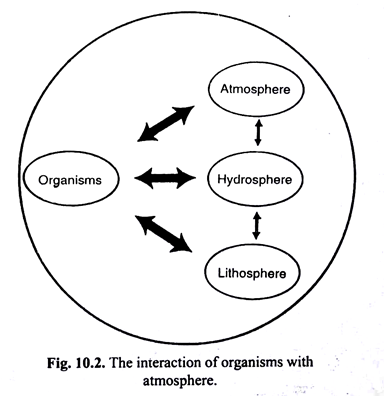The following points highlight the seven major ecological levels of organisations. The ecological levels are: 1. Organisms 2. Population 3. Biological Community 4. Ecosystem 5. Landscape 6. Biome 7. Biosphere.
Ecological Level # 1. Organisms:
They make the basic unit of study in ecology. At each level, the biological unit has a specific structure and function. At this level, the form, physiology, behaviour, distribution and adptations in relation to the environmental conditions are studied.
The organisms of the similar type have the potential for interbreeding, and produce fertile offspring, which are called species.
The organism performs all the life processes independently. However, parts of organism cannot exist independently of one another.
An organism is fully adapted to its environment. It has a definite life span including definite series of stages like birth, hatching, growth, maturity, senescence, aging and death.
Competition, mutualism and predation are various types of interaction between organisms.
Ecological Level # 2. Population:
In ecology, a population is a group of individuals of the same species, inhabiting the same area, and functioning as a unit of biotic community.
For example, all individuals of the common grass, Cynodon, in a given area constitute its population. Similarly, the individuals of elephants or tigers in an area constitute their population.
The interaction between populations is generally studied. These interactions may be a predator and its prey, or a parasite with its host. Competition, mutualism, commensalism, parasitism, and predation are various types of interactions.
Ecological Level # 3. Biological Community:
Biotic community organisation results from interdependence and interactions amongst population of different species in a habitat. This is an assemblage of populations of plants, animals, bacteria and fungi that live in an area and interact with each other.
A biotic community is a higher ecological category next to population. These are three types of biotic community, they are: animals, plants and decomposers (i.e., bacteria and fungi). A biotic community has a distinct species composition and structure.
Ecological Level # 4. Ecosystem:
The ecosystems are parts of nature where living organisms interact amongst themselves and with their physical environment. An ecosystem in composed of a biotic community, integrated with its physical environment through the exchange of energy and recycling of the nutrients. The term ecosystem was coined by Sir Arthur Tansley in 1935.
Ecosystems can be recognised as self- regulating and self-sustaining units of landscape, e.g., a pond or a forest.
An ecosystem has two basic components:
(i) Abiotic (non-living), and
(ii) Biotic (living organisms).
Abiotic components comprise inorganic materials, such as carbon, nitrogen, oxygen, CO2, water etc., while biotic components include producers, consumers and decomposers.
Ecological Level # 5. Landscape:
A landscape is a unit of land with a natural boundary having a mosaic of patches, which generally represent different ecosystems.
Ecological Level # 6. Biome:
This is a large regional unit characterised by a major vegetation type and associated fauna found in a specific climate zone. The biome includes all associated developing and modified communities occurring within the same climatic region, e.g., forest biomes, grassland and savanna biomes, desert biome, etc.
On a global scale, all the earth’s terrestrial biomes and aquatic systems constitute the biosphere.
Ecological Level # 7. Biosphere:
The entire inhabited part of the earth and its atmosphere including the living components is called the biosphere.
The global environment consists of three main sub-divisions:
(i) The hydrosphere which includes all the water components,
(ii) The lithosphere comprises the solid components of the earth’s crust, and
(iii) The atmosphere formed of the gaseous envelope of the earth. The biosphere consists of the lower atmosphere, the land and the oceans, rivers and lakes, where living beings are found.

